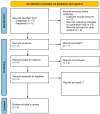RNF213 Polymorphisms in Intracranial Artery Dissection
- PMID: 38927660
- PMCID: PMC11203323
- DOI: 10.3390/genes15060725
RNF213 Polymorphisms in Intracranial Artery Dissection
Abstract
The ring finger protein 213 gene (RNF213) is involved in several vascular diseases, both intracranial and systemic ones. Some variants are common in the Asian population and are reported as a risk factor for moyamoya disease, intracranial stenosis and intracranial aneurysms. Among intracranial vascular diseases, both moyamoya disease and intracranial artery dissection are more prevalent in the Asian population. We performed a systematic review of the literature, aiming to assess the rate of RNF213 variants in patients with spontaneous intracranial dissections. Four papers were identified, providing data on 53 patients with intracranial artery dissection. The rate of RNF213 variants is 10/53 (18.9%) and it increases to 10/29 (34.5%), excluding patients with vertebral artery dissection. All patients had the RNF213 p.Arg4810Lys variant. RNF213 variants seems to be involved in intracranial dissections in Asian cohorts. The small number of patients, the inclusion of only patients of Asian descent and the small but non-negligible coexistence with moyamoya disease familiarity might be limiting factors, requiring further studies to confirm these preliminary findings and the embryological interpretation.
Keywords: RNF213; atherosclerosis; intracranial artery dissection; intracranial stenosis; magnetic resonance angiography; moyamoya disease.
Conflict of interest statement
The authors declare no conflicts of interest.
Figures


References
-
- Liu W., Morito D., Takashima S., Mineharu Y., Kobayashi H., Hitomi T., Hashikata H., Matsuura N., Yamazaki S., Toyoda A., et al. Identification of RNF213 as a susceptibility gene for moyamoya disease and its possible role in vascular development. PLoS ONE. 2011;6:e22542. doi: 10.1371/journal.pone.0022542. - DOI - PMC - PubMed
-
- Hashimoto N., Tominaga T., Miyamoto S., Nagata I., Houkin K., Suzuki N., Takagi Y., Research Committee on the Pathology and Treatment of Spontaneous Occlusion of the Circle of Willis. Health Labour Sciences Research Grant for Research on Measures for Infractable Diseases Guidelines for diagnosis and treatment of moyamoya disease (spontaneous occlusion of the circle of Willis) Neurol. Med. Chir. 2012;52:245–266. - PubMed
Publication types
MeSH terms
Substances
LinkOut - more resources
Full Text Sources

